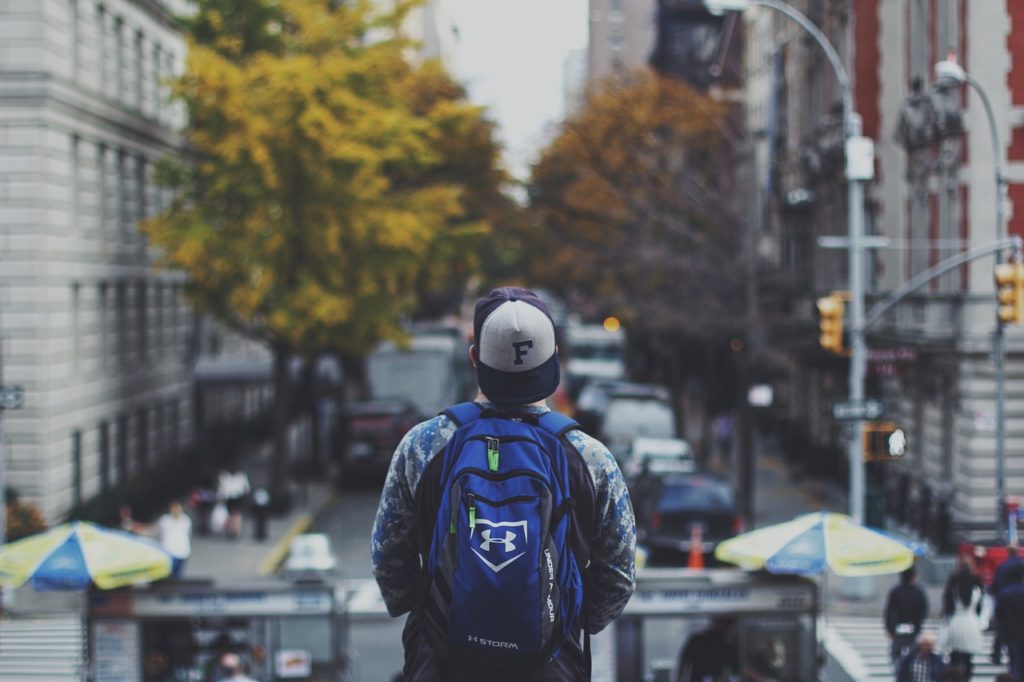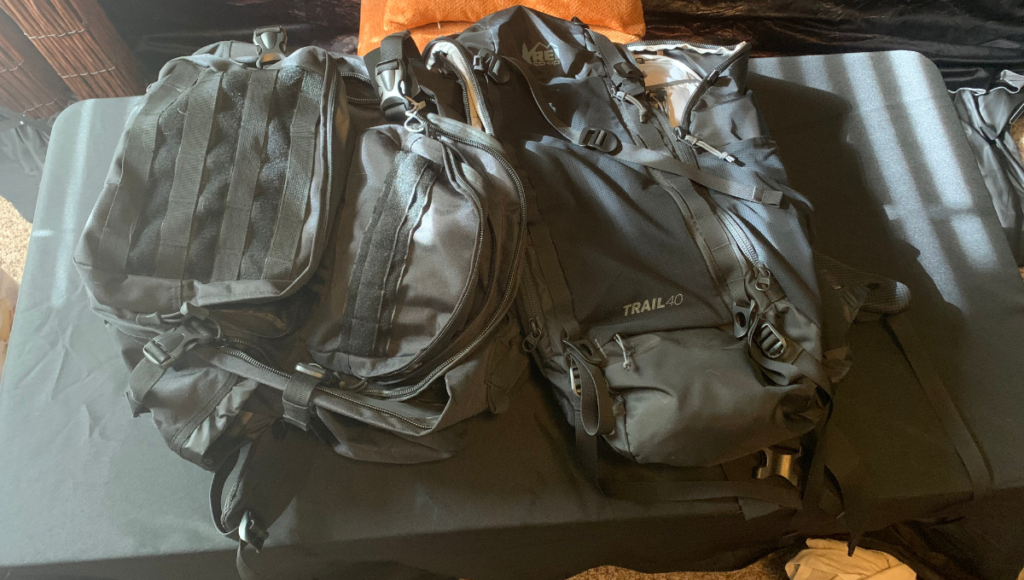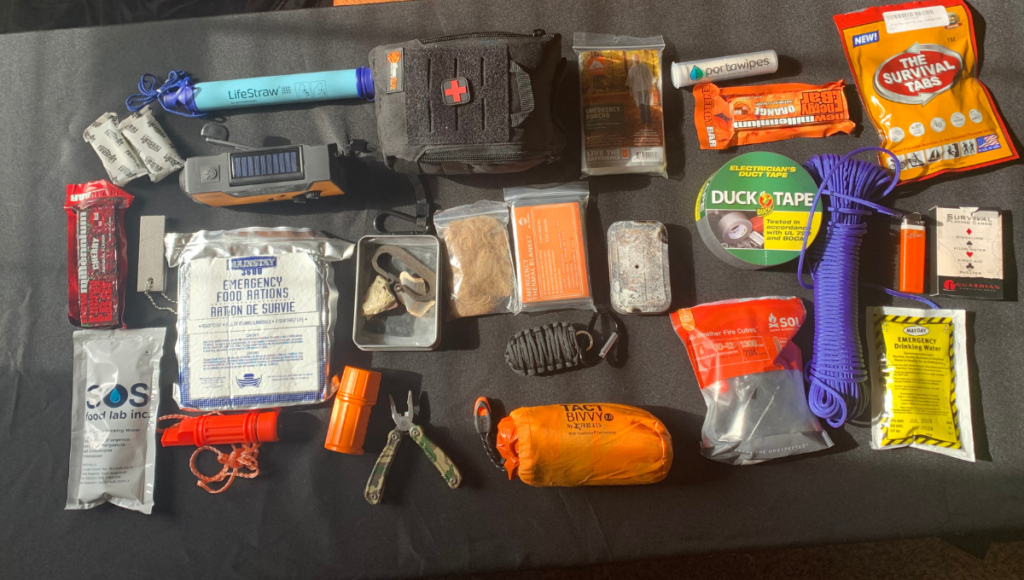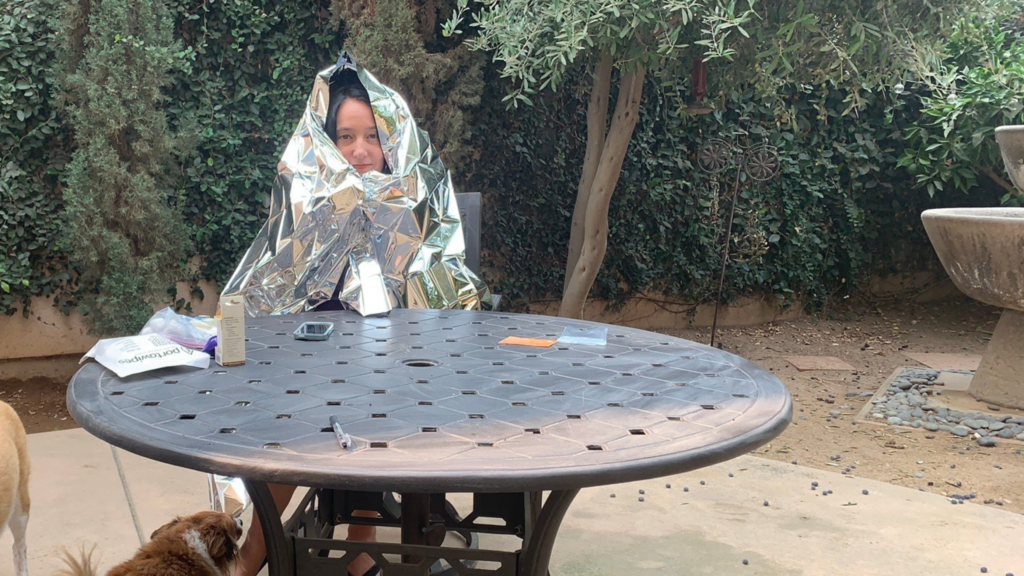Last Updated on May 12, 2023 by Lisa Vargas
If you’ve been prepping for any length of time, you’ve probably realized there are several different SHTF scenarios that can happen, including being away from home when disaster strikes. It’s extremely important to know how to build a get home bag so that you increase your chances of getting back home safely.
In this post today we are going to cover the following things:
- What is a get home bag exactly?
- Why you should build a get home bag?
- Who should build a get home bag?
- Where should you keep your get home bag once it’s built?
- How to choose the best get home bag
- Things to consider when building a get home bag
- A comprehensive list of all of the items you need in your get home bag
If you are new to survival or have been around for a while, you have probably heard people talk about building a bug out bag.
This is a pack with gear designed for you to leave your home for an indefinite amount of time. You might even have one built already.
As you become more experienced with survival, you will hear people talk about their everyday carry (EDC) kits. These are items you keep on you at all times in case of an emergency.
Probably the least common survival kit you will hear about is a get home bag (GHB). Think about it for a minute.
Unless disaster strikes at night, there is a good chance you will be at work, at school, or out running errands during the day.
You need to have a way to get home to your family and decide if you are bugging out or bugging in.
In this article, we will cover how to build a get home bag and what should be included.
What is a Get Home Bag?

A get home bag is simply a pack you keep in your car or at your office specifically designed to help you get home.
It should be smaller and lighter than a bug out bag, but more complete than a standard everyday carry kit. Each item in your get home bag is selected to get you home.
Looking at census data, the average length of commute is just under 30 minutes. Depending on where you live, that could be a 3 mile bus ride or a 25 mile trip on the highway.
You should customize a get home bag to your personal situation, so longer commutes require more gear.
For this article, we will say that the bag should help you cover anywhere from 5 to 20 miles.
Why Build a Get Home Bag?
After you take the time to build a bug out bag and an everyday carry kit, you might ask why you should take the time and money to build another bag. For this I want you to really think about possible SHTF scenarios.
Let’s say you spend 40 plus hours a week away from home at your job. In addition, you have a few more hours of running errands or picking up kids. This means at least 30% of your available hours each week are spent away from your bug out bag. To truly be prepared, you need to account for that time.
So you are at your office and maybe a tornado touches down in your town. This happened just last year about 20 miles from where I live. If you are not injured, you will need to find a way to get home.
Maybe there is massive flooding like what happened with Hurricane Katrina or Hurricane Sandy. Maybe there are wildfires pushing into the area like we have seen in the West the last few years.
Perhaps a peaceful demonstration turns into a riot just outside your office building. Whatever the case may be, you will need to find a way to get home. Unfortunately, driving home is not an option with many of these scenarios.
Whether it is standing water, down power lines, or a sea of angry protesters… you may have obstacles keeping you from using your vehicle. Your get home bag will have the supplies needed to make that trip and get home to your loved ones.
Who Should Build a Get Home Bag?
The short answer is everyone should build a get home bag. Most people spend the majority of their daytime hours at a job or school. These are the obvious scenarios when a get home bag could save your life.
However, I don’t know anyone that stays home 100% of the time. Even my retired friends and relatives spend a few hours a day at the grocery store, hardware store, or golf course. Of course there are some people that are away from home more than others, but that is no excuse.
Get home bags are not expensive to assemble, so everyone should have one in their trunk.
Where Should I Keep my Get Home Bag?
When considering the location of your get home bag, you should think about where you spend most of your time away from home. You want to be able to get to the bag quickly. I like to keep mine in the trunk of my car.
Usually when I am out and about it is easy enough to get back to my car to get my bag. However, if you work on the seventh floor of an office building your situation is different than mine.
If you park and walk eight blocks to work, that is also more difficult. If you have lockers or an empty desk drawer, those are good places to keep your get home bag. My suggestion would be to keep it in your vehicle but take it inside with you if there is a discreet place for it.
No, you don’t want all of your survival gear on display at your office. However, if you can bring it with you and hide it somewhere it could improve your readiness.
How to Choose the Best Get Home Bag

With any survival kit, the bag itself is very important. It needs to be large enough to carry the needed gear, but small enough that it is easy to carry. It should be comfortable for longer trips.
It should also be discreet for times you bring it inside at work or the gym. Finally, it should be durable so you don’t need to replace it after a year or two.
Just pulling it out of your trunk every day will cause some wear and tear.
Lets talk about the size of the bag. Again, this should be adjusted based on your particular needs. If you have 20 miles to hike, your bag should be larger than if you have five miles to hike.
A 20 mile trip typically means spending the night along the way. A five mile hike can usually be done in one day. This greatly affects the gear you will need.
I like to use either a standard sized backpack or something slightly smaller. A large purse can work for women.
You can use a duffel bag if you go to the gym, but it would be more difficult to carry over long distances.
A standard bookbag is not going to stand out in a work or school environment. You can get normal looking packs that have comfortable straps and multiple compartments to organize your gear.
I have also used a one strap pack for my get home bag. This is about half the size of a backpack with a single shoulder strap instead of two. This would be ideal for a shorter trip home.
A good example of the type of bag you want to consider is the 5.11 Tactical Rush 72 Hour Bug Out Bag. This bag is the same size as a normal backpack.
However, it has internal framing, a waist belt, and multiple compartments inside and out. This would be ideal for longer hikes because the weight of the pack is mainly on your hips and not your shoulders.
The compartments make it easy to keep all of your gear organized. It is water resistant so your gear does not get wet in the rain.

It is also important to be sure the pack fits the person properly. I recently did a long distance survival challenge with an internal frame pack I used when I was younger. The waist belt and shoulder straps no longer fit quite right, but I thought I’d try the hike anyways.
The added weight on my shoulders reinjured a torn rotator cuff I have been dealing with, and two weeks later I am still in severe pain. Be sure to try on your pack and consider details like this before you buy one.
If you buy one and it doesn’t fit right once it is full, take it back and get one that does.
Things to Consider when Building a Get Home Bag

Building any survival kit requires a delicate balance. You want to have plenty of gear to help you get home safely, but you also want to keep your pack light so you can travel quickly. There is a strategy I use every time I put together a new kit or revise an existing one.
I start by laying out all of the gear that I would like to have with me considering the climate and the length of the trip. For example, the most likely trip home I would make would be from my wife’s school since I work from home.
That is about a five-mile hike through a combination of neighborhoods and wooded spaces. There is water along the way, and there would be heavy exposure to other people. This time of the year the trip would be a chilly one.
For this particular pack I would set out the tools needed for a daytime hike in cold weather. I would also set out backup supplies in case I could not get home before dark and needed to set up camp.
This first list of gear is always too large. I then go through my gear and get rid of anything I don’t absolutely need, especially large or heavy items. For example, I would love to have a gallon of drinking water with me.
However, it is bulky and heavy. I’m better off to bring a filter bottle and find water sources along the way. Once I have eliminated anything I don’t need, I then put it all in my pack and try it on.

If it still feels too heavy, I will empty it and go back through my list. Also, if it does not all fit in the pack I will make adjustments. This goes on for a few days until I am happy with my final kit.
The best way to prioritize gear is to focus on items with multiple uses. For example, I have a ferro rod with a built in compass and emergency whistle. This is perfect as it is small and lightweight, but helps with fire, navigation, and signaling for help.
I have tons of survival tools like this that cover multiple needs. Also, be selective and purchase quality equipment. You are better to bring one good knife with you versus three knives that will dull or break easily.
How To Build A Get Home Bag
It is important that you stay organized and prioritize your gear as you put together your list. Always start with covering your needs for the four pillars of survival: food, water, fire, and shelter.
Then move on to secondary needs like navigation, signaling for help, self-defense, and first aid. Finally, fill in the gaps with anything else that you feel you need. Keep in mind that you are only looking at one to three days of hiking.
The rule of threes states that you can survive three weeks without food, three days without water, and three hours without warmth from fire or shelter. Because of this, water and warmth will be more important than food.
Items To Include in Your Get Home Bag

Here are some items to consider for your get home bag:
Water Filter
While getting home is typically a one or two day trip, hydration is still very important. When you are hiking all day, you will burn through water quickly. If you get dehydrated, it will significantly slow your pace.
Bringing water with you is tough because of the weight.
If anything, I might bring one small bottle of water. However, I always bring a water filter with me such as the Lifestraw Personal Water Filter. These filter 99.999% of harmful pathogens from your drinking water.
Without purification, drinking rancid water can make you sick with several different waterborne illnesses. These cause diarrhea and vomiting which often leaves you even more dehydrated.
I like a filter bottle because I can carry water with me and drink when I want. You can also pick up a straw style filter.
Iodine Tablets
I bring iodine tablets strictly as a backup plan for hydration. There have been times that my filter has gotten clogged on a survival challenge. When this happens, iodine tablets can still get the job done.
Just drop a couple in a bottle of water and 30 minutes later it is safe to drink. The vial is really small, so there is virtually no weight added to your pack.
Fire Starters
The one fire starter that I always pack is a ferro rod. This tool is windproof, waterproof, requires no fuel, and shoots out sparks at about 3000F.
It is the most reliable firestarter that you can have with you. I also bring a cheap lighter in case I am in a hurry for a fire. You will not always need a fire to get home, but if you get wet or camp overnight then it will be helpful.
You need to have fire as an option for warmth, boiling water, and cooking food. This is especially true if you will be hiking for more than one day.
Premade Tinder
In addition to bringing firestarters, I like to have a few Wetfire cubes with me. These waxy cubes are individually wrapped so they last longer. If you shave off some of the wax it will start with a spark from your ferro rod and stay lit for several minutes.
It works even when wet or windy. Especially if you have lousy weather, these little cubes can make starting a fire much easier. They also add virtually no weight to your pack.
I completed a wintertime survival challenge a few years ago and snow had made all of the good tinder damp. I tried to start a fire for three hours with no luck.
Having waterproof tinder is a definite plus.
Preserved Food
I like to bring a little preserved food to keep my energy up. I usually have a couple meal replacement bars and some dry oatmeal.
If I need to warm up I can cook the oatmeal over a fire, and on the go I can eat the meal replacement bars. This stuff is lightweight and takes up little space.
Ration bars also work very well for a get home bag but they can be a little heavy so pack them only if you have the room and enough weight capacity left.
Emergency Blanket and Rain Poncho
You never know when disaster will strike, and it could be cold or rainy outside. You need to have a way to keep your clothes from getting wet as hypothermia could set it. This is where a bivy sack or an emergency blanket comes in handy.
The human body loses warmth 20 times faster when wet versus when dry. It is also helpful if this tool can double as a tent if you need to get some sleep. A good tarp style emergency blanket will reflect 90% of your body heat back to you.

It is also waterproof and can be used to just wrap up and stay warm.
Ponchos are nice in that you can wear them while you hike and can use them as a tent, but they do not retain as much heat. If you want the best of both worlds, bring a cheap poncho and a cheap space blanket.
The large tarp style blankets take up some space, so you might choose the other options which are much smaller.
550 Paracord
Cordage is always important as it is difficult to make out of natural materials. Whether it is used to build a shelter, purify water, or start a fire you always want to have strong cordage. I choose 550 paracord because it can hold 550 lbs of weight.
It also can be split open to use the interior strands, so 10 feet of paracord is actually more like 80 feet of cordage once split open. Paracord is also great because you can carry it in multiple ways.
I like to replace my boot laces with paracord, but you can also weave a lanyard or bracelet if you prefer.
Knife
The most valuable tool you have in any survival kit is a good knife. I completed a knife only survival challenge a few years ago on which the only tool I was permitted was a knife. Despite steady rain the whole time, I was able to get by for several days with just my blade of choice.
A knife can be used for first aid, self-defense, shelter building, fire starting, and dozens of other tasks.

You should have one quality knife with a high carbon steel blade for your primary knife. I prefer full tang knives because they are less likely to break. For survival purposes it should have a blade between three and ten inches long from the handle.
This allows you to use it for tough jobs like batoning firewood or more delicate jobs like dressing game. I also suggest having a backup knife either in your pack or in your pocket. Pay attention to steel quality as low quality steel will dull quickly.
Map and Compass
If you do not have access to GPS on your phone or in your vehicle, you will need to be able to find your way home. If you are on foot, there is a good chance that you will not be following roads the whole time.
Even if you have GPS, it often will not help with a trip like this. You should always have a map that covers the area between your home and where you spend your days. In addition, you should have a good compass to help you orient your map.
Most people do not pay close attention to cardinal directions on the way to work or school. A map and compass do not need to take up much space, but you can also buy lots of different types of gear that have compasses built-in.
Emergency Whistle
Even if you have just a short hike back home after SHTF, things can go wrong. It is easy to get a bad cut or twist an ankle. Often you are not far from help, but you need to get the attention of potential rescuers.
An emergency whistle can assist with this. The sound cuts through wind and traffic noise and can be heard much better than just yelling for help.
They are small and lightweight, plus you can buy gear with an emergency whistle built in.
Emergency Mirror
If you happen to get hurt or stuck further away from civilization, an emergency signaling mirror can help. There is a sight hole cut in the center so you can aim the mirror at a helicopter or a vehicle.
You then use light from the sun to flash your target and get their attention. These are typically made of plastic and are small and lightweight.
Small First Aid Kit
You should not need much medical care if you are preparing to hike home. However, you may have some cuts and scrapes along the way. You can put together a small first aid kit with bandages, disinfectant, and a few other essentials.
You should be able to fit what you need in your pocket, so don’t go crazy with your kit. The big first aid kit is for your home or bug out bag. You can also learn how to build your own first aid kit or you can buy one yourself here.
Firearm
I know some people are comfortable carrying a handgun and some are not. That being said, a small weapon in your get home bag is a good idea. Obviously, you can conceal carry and still be good to go.
In this scenario, you are leaving a heavily populated area in most cases. People may become violent and you want to be prepared to defend yourself if needed.
Socks
There is a good chance that your feet will get wet on your trip home. You do not want to keep hiking in wet socks if you can avoid it. I always keep at least one extra pair of wool socks in my get home bag.
They are warm, provide good padding to avoid blisters, and will keep you warm even when wet. Wool is the only natural substance on earth that can do that.
Boots
I think it is fair to say that most people do not wear hiking boots to work or school every day. If you are traveling any distance, proper footwear is vital. One of the best places to get high-quality tactical boots is from 5.11 Tactical.
Without it you can easily slip and fall or twist an ankle. Keeping some good footwear with your get home bag is a good idea.

Hat
Whether it is a baseball cap or an insulated winter hat, keeping your head covered is smart. It can protect your head and face from sun exposure and a random scratch from tree branches.
On my very first survival challenge I took off my hat for just a moment and got a nasty gash on my head. Hats will help keep biting insects away from your head and help keep sweat out of your eyes.
Ball caps will keep the sun out of your eyes, and winter hats will hold in a huge amount of body heat that escapes through your head. In cold weather it is an absolute must.
Gloves
With the rough terrain you may encounter and the work you may be doing, your hands should be protected. You can wear anything from leather work gloves to motorcycle gloves and get the job done.
I personally like tactical fingerless gloves. My hands stay protected and warm, but I still have all of the dexterity I normally have with my fingers. Wearing these gloves, I have never gotten any cuts or blisters on my hands.
You can find a wide variety of gloves at 5.11 Tactical. Again, I keep mentioning this company because they are one of the best-quality you can get anywhere.
Shemagh
This is really just an extra large bandana but is so much more useful. There are several ways they can be worn on the head or neck to protect from sun, wind, sand, insects, and cold.
They can be used to mask your identity if needed for the situation. You can cut it up into strips for cordage if needed, use it to help filter water, or hang your food in a bear bag.
You can even use a strip as toilet paper in a jam.
Warm Jacket
While you want to be dressed in one layer of loosely fitting clothing for the hike, you will need to stay warm during breaks. Having some sort of warm jacket, coat, or vest will hold in body heat around your core to help you stay warm when you aren’t hiking.
You can get a serious chill going in only 10 or 15 minutes if it is cold out and you are not moving.
Folding Saw
You may need to cut wood for a shelter or for firewood. If this is the case, a small folding saw is the best option I have found.
Mine is only about eight inches long when folded and weighs less than a pound. However, I can easily cut anything up to four inches in diameter. This is plenty big for a get home bag.
Flashlights and Headlamps
If it gets dark and you are just a mile or so from your home, you may want to push through in the dark. It is not a good idea, but a risk may be needed if your family is in danger at home. Having a good source of light is a must.
Without light, you will end up tripping and hurting yourself before you get to your destination. I have a small aircraft aluminum LED flashlight that is waterproof and basically indestructible. Always get a flashlight with at least 800 Lumens so you can clearly see your path.
It is nice if it has features like an adjustable beam or a strobe setting for self-defense. You can get all of these same features in a headlamp. The benefit is that strapping your light on your head frees up your hands to carry gear or brace yourself if you lose your step.
Both options are small and weigh less than a pound.
Related Content: Best Survival Flashlight: A Buyer’s Guide
Duct Tape
Well, you just never know what you are going to need Duct Tape for. I have used it for rips in emergency blankets, a hole in a sleeping mat, stopping the bleeding on a bad cut, and keeping my feet and legs dry while wading a creek.
There are so many more ways you can use duct tape. If nothing else, you can twist it up and use it for cordage. The primary reason I keep it in my pack is for wading. My boots are waterproof, and my pants are typically water-resistant.
If I start wrapping at my ankles and wrap up to my knees, I can usually wade most creeks without getting wet. I just take off the tape when I get to the other side. I do not typically take a whole roll as it can be bulky, so a half or less is ideal.
Other Items To Consider
There are lots of other tools to potentially pack depending on your personal needs. You can bring a small backpacking tent if you want. These work much better in high winds or rain, and you can set it up in 5 minutes.
You could bring a sleeping mat to insulate you from the ground. You could bring a sleeping bag or bivy sack to stay warmer at night. These items make more sense if you have a longer commute.
You can bring a pocket stove and a gas tank for cooking in a hurry. There are lots of other fire starters that you might prefer to lighters and ferro rods. There are also other tools for cutting wood such as pocket chainsaws, hatchets, bush axes, frame saws, or machetes.
If you want to get really tech savvy you can buy a programmable GPS and program in your work and home locations.
In the end, the choice of gear is up to you. Just remember to keep that balance. Take only the items you think you need to get home, so you keep your pack as light as possible.
Be sure to trim down your list as much as possible. Then pack it up and try hiking with it to judge the weight and balance. Keep in mind that most people are more likely to use their get home bag than any other survival kit they have.
You need to check your get home bag a few times a year to adjust your gear with the seasons.
With everything that is going on in the world today, each adult in your home should have a plan to safely get you family together at home. Maybe your plan requires a quick stop at the elementary school to pick up your son.
Maybe your wife needs to pick up her elderly mother on the way. Whatever the plan is, get your packs ready and discuss the plan in advance. It could mean the difference between life and death.
